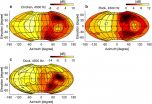(Press-News.org) Worcester, Mass. - A new statistical model developed by a research team at Worcester Polytechnic Institute (WPI) may enable physicians to create personalized cancer treatments for patients based on the specific genetic mutations found in their tumors.
Just as cancer is not a single disease, but a collection of many diseases, an individual tumor is not likely to be comprised of just one type of cancer cell. In fact, the genetic mutations that lead to cancer in the first place also often result in tumors with a mix of cancer cell subtypes.
The WPI team developed a new statistical model that uses an advanced algorithm to identify these multiple genetic subtypes in solid tumors by analyzing gene expression data from a small biopsy sample. The results can help shape more effective cancer treatments and also guide future research. Details of the new model are reported in the paper "GLAD: A mixed-membership model for heterogeneous tumor subtype classification" published by the journal Bioinformatics.
"Many of the statistical models used today to classify tumors are limited by an 'all-or-none' approach," said Patrick Flaherty, PhD., assistant professor of biomedical engineering at WPI and senior author of the new paper. "In other words, they classify only a single, dominant cancer cell subtype in a tumor, but that can be misleading. A drug that can target one subtype of cancer cells may have no effect on another subtype. So we set out to develop a model that could more accurately predict the multiple fractions of cancer cell subtypes in a tumor."
Cancer cells proliferate unchecked because genetic mutations enable them to grow in an abnormal way and evade the body's natural defenses. As a tumor grows, those cancer cells multiply and evolve, forming clusters of different subtypes. Each subtype can be identified by the unique pattern of the products produced by their genes. With the cost of DNA sequencing tests that produce this type of data decreasing, the need for statistical tools to handle the flood of data and create relevant information that physicians can use in real time increases.
"Because clinical labs can now sequence the genomes of a patient's cancer cells, prognosis and treatment is becoming a big data problem," Flaherty said. "Our lab is focused on extracting actionable information from big data sets so physicians and patients can make better decisions."
As reported in their paper, Flaherty's team developed a new model called GLAD (for Gaussian, Laplace, and Dirichlet, the statistical distributions in the model). They first tested GLAD on a simulated data set built to resemble gene expression patterns of a tumor with two subtypes of cancer cells. The model identified the correct fractions of the two subtypes. Next, GLAD used gene expression data to accurately determine the percentages of rat lung, brain, and liver cells in a sample with known proportions of those cells. Finally, GLAD was applied to gene expression data from 202 glioblastoma (human brain tumor) samples obtained from the Cancer Genome Atlas Project. Glioblastoma tumors are thought to have four subtypes of cells, and GLAD accurately predicted the fraction of each.
Looking ahead, Flaherty is exploring collaborations with clinical partners who are treating breast cancer patients. The hope is to apply the GLAD model to gene expression data from patient biopsies over time and see how the results correlate with the patients' outcomes and the chemotherapies used. Flaherty has also made the complete GLAD model available for downloading by colleagues around the world to test and apply in their research.
"We are looking forward to the clinical testing and are hopeful that in the coming years the model will be helpful for physicians as they treat patients with combinations of therapies that are effective against an entire tumor," Flaherty said
INFORMATION:
Flaherty's co-authors on the GLAD paper are Jon McAuliffe, PhD, of the University of California at Berkeley, and Hachem Saddiki, who was a visiting undergraduate student when the GLAD model was in development and is now a graduate student in Flaherty's group at WPI.
About Worcester Polytechnic Institute
Founded in 1865 in Worcester, Mass., WPI is one of the nation's first engineering and technology universities. Its 14 academic departments offer more than 50 undergraduate and graduate degree programs in science, engineering, technology, business, the social sciences, and the humanities and arts, leading to bachelor's, master's and doctoral degrees. WPI's talented faculty work with students on interdisciplinary research that seeks solutions to important and socially relevant problems in fields as diverse as the life sciences and bioengineering, energy, information security, materials processing, and robotics. Students also have the opportunity to make a difference to communities and organizations around the world through the university's innovative Global Perspective Program. There are more than 40 WPI project centers in the Americas, Africa, Asia-Pacific, and Europe.
The once mighty super typhoon has weakened to a depression in the South China Sea as it heads for a final landfall in southern Vietnam. NASA's Aqua satellite captured an image of the storm that showed it was weakening.
NASA's Aqua satellite passed over Hagupit on Dec. 11 at 05:20 UTC (12:20 a.m. EST) and the MODIS instrument captured a visible image of the storm. The MODIS image showed that the thunderstorms had become fragmented around the circulation center.
On Dec. 11 at 1500 UTC (10 a.m. EST) Tropical Depression Hagupit's maximum sustained winds dropped to 30 knots ...
San Antonio -- December 11, 2014 -- Southwest Research Institute (SwRI) is preparing to unveil a new, miniature portable solar observatory for use onboard a commercial, manned suborbital spacecraft. The SwRI Solar Instrument Pointing Platform (SSIPP) will be on exhibit at the fall meeting of the American Geophysical Union (AGU), Dec. 16-19, at the Moscone Center in San Francisco, Calif.
Using reusable suborbital commercial spacecraft for the SSIPP development effort improves on a traditional space instrument development process that goes back to the dawn of the space ...
DARIEN, IL - A new study shows that paid work time is the primary waking activity exchanged for sleep and suggests that chronic sleep loss potentially could be prevented by strategies that make work start times more flexible.
Results show that work is the dominant activity exchanged for less sleep across practically all sociodemographic categories. Compared to normal sleepers, short sleepers who reported sleeping 6 hours or less worked 1.55 more hours on weekdays and 1.86 more hours on weekends or holidays, and they started working earlier in the morning and stopped working ...
December 11, 2014 - Hospitals with robotic surgical systems are more likely to perform "nephron-sparing" partial nephrectomy--a recommended alternative to removal of the entire kidney--in patients with kidney cancer, reports a study in the December issue of Medical Care. The journal is published by Lippincott Williams & Wilkins, a part of Wolters Kluwer Health.
"Hospital acquisition of the surgical robot is associated with greater proportion of partial nephrectomy, an underutilized, guideline-encouraged procedure," write Dr Ganesh Sivarajan of New York University Langone ...
An interstellar mystery of why stars form has been solved thanks to the most realistic supercomputer simulations of galaxies yet made.
Theoretical astrophysicist Philip Hopkins of the California Institute of Technology (CalTech) led research that found that stellar activity -- like supernova explosions or even just starlight -- plays a big part in the formation of other stars and the growth of galaxies.
"Feedback from stars, the collective effects from supernovae, radiation, heating, pushing on gas, and stellar winds can regulate the growth of galaxies and explain why ...
Unlike mammals, birds have no external ears. The outer ears of mammals play an important function in that they help the animal identify sounds coming from different elevations. But birds are also able to perceive whether the source of a sound is above them, below them, or at the same level. Now a research team from Technische Universität München (TUM) has discovered how birds are able to localize these sounds, namely by utilizing their entire head. Their findings were published recently in the PLOS ONE journal.
It is springtime, and two blackbirds are having ...
NEW YORK, NY - Patients with operable kidney cancers were more likely to have a partial nephrectomy -- the recommended treatment for localized tumors -- when treated in hospitals that were early adopters of robotic surgery, according to a new study.
Researchers from NYU Langone Medical Center and elsewhere, publishing online December 11 in the journal Medical Care, report that by 2008, hospitals that had adopted robotic surgery at the start of the current century (between 2001 and 2004) performed partial nephrectomies in 38% of kidney cancer cases compared to late adopters ...
Novel research reveals that the risk of acute gout attacks is more than two times higher during the night or early morning hours than it is in the daytime. The study published in Arthritis & Rheumatology, a journal of the American College of Rheumatology (ACR), confirms that nocturnal attacks persist even among those who did not consume alcohol and had a low amount of purine intake during the 24 hours prior to the gout attack.
The body produces uric acid from the process of breaking down purines--natural substances in cells in the body and in most foods--with especially ...
Parkinson's disease sufferers have a different microbiota in their intestines than their healthy counterparts, according to a study conducted at the University of Helsinki and the Helsinki University Central Hospital (HUCH).
"Our most important observation was that patients with Parkinson's have much less bacteria from the Prevotellaceae family; unlike the control group, practically no one in the patient group had a large quantity of bacteria from this family," states DMSc Filip Scheperjans, neurologist at the HUCH Neurology Clinic.
The researchers have not yet ...
A team of researchers led by North Carolina State University has found that stacking materials that are only one atom thick can create semiconductor junctions that transfer charge efficiently, regardless of whether the crystalline structure of the materials is mismatched - lowering the manufacturing cost for a wide variety of semiconductor devices such as solar cells, lasers and LEDs.
"This work demonstrates that by stacking multiple two-dimensional (2-D) materials in random ways we can create semiconductor junctions that are as functional as those with perfect alignment" ...



